December 10, 2022
Eyedrum Art & Music Gallery
Atlanta, GA
Jan Berry Baker, saxophone; Stuart Gerber, percussion; Amy Petrongelli, soprano; Erika Tazawa, piano; Daniel Tosky, double bass.
Alvin SINGLETON: Every Next Day (2022)*
Adam MIRZA: cracks (2019)
Andrew STANILAND: Blue (2008)
Emily KOH: hyd(e)rOsion (2022)*
George LEWIS: Tuning In (2022)*
George CRUMB: Madrigals, Book I (1965)
*Southeaster premiere
Jon Ciliberto | 13 NOV 2022
Jan Berry Baker and Stuart Gerber, Co-Artistic Directors of Georgia State University’s ensemble in residence Bent Frequency, have added many works to the repertoire for saxophone and percussion. Saturday’s program featured three “Southeastern Premieres” for that pair of instruments, with the works’ three composers in attendance.
One imagines the pair of instruments as a cousin of the more traditional pairing of string instrument and piano. Various mallet instruments stand in for the piano (both a percussion and a string instrument), providing harmonic structure against single-voiced reeds. (Mostly single voice — modern compositions often call for harmonics and other methods of eking out more.)
Percussion, especially drums and cymbals, need a more muscular partner than stringed instruments, and the saxophone has the strength to match them dynamically. A pre-history might be located in jazz and Karlheinz Stockhausen. Scores for the pair started to appear in earnest in the 1980s, accelerating considerably since then.
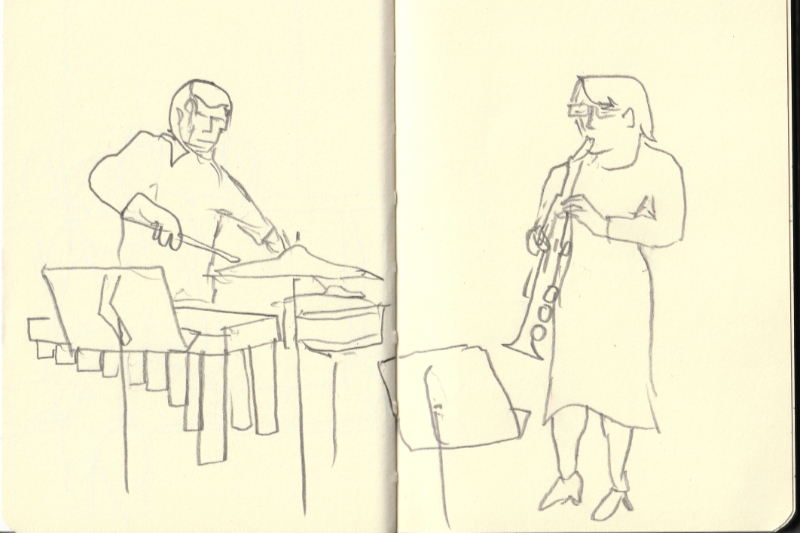
Stuart Gerber and Jan berry Baker. (sketch by Jon Ciliberto)
Perhaps the modern sensibility and adaptability of the pairing has also encouraged contemporary composers to take up writing for these two instruments. Baker and Gerber’s devotion to new works has found a happy match with the increasing interest amongst composers, resulting in a string of commissions for Bent Frequency.
Three works composed in 2022 were on the program. The much-honored (probably not enough) Atlanta-based composer Alvin Singleton’s Every Next Day, commissioned by Baker and Gerber, opened the evening in Eyedrum’s West End performance space.
Vibraphone and saxophone often mirror one another through flying passages, answered by spacious, ruminative responses. This back and forth between energetic, melodically cascading forms and slow, extended phrases gives way to less paralleled interaction between the instruments. In brief comments, the composer spoke of a compositional interest in discovering the colors found in mixing the two instrumental voices, and this especially reached my ears in the careful use of each voice’s dynamics and the open space given to each to meet up in the air.
cracks (2019) by Adam Mirza, composed for Baker and Gerber, placed the former at the back of the room, with Gerber playing a snare drum (sometimes with crumpled paper and aluminum foil on the drum head). The score indicates a range of non-standard and improvisational techniques for both instruments, e.g., saxophone: “subtone, submerged sound, mumbly,” “purring,” “warbling,” “raunchy, bright, controllable”; percussion: “freely move about the snare surface, change speed and dynamics freely. These, combined with the instrument separation in the room, created a sense of tension throughout.
Blue (2008), composed by Andrew Staniland for mezzo-soprano and piano resonance, was performed by soprano Amy Petrongelli and pianist Erika Tazawa and confronted listeners with an unexpected tableau: Petrongelli faced away from the audience, singing into the body of the piano, and Tazama, largely motionless, but using open pedal and finger scraping of the piano’s strings (a sharp, harpsichord effect). Petrongelli’s, at volume, rang out with the piano’s unkeyed resonance in a mysteriously evocative manner.
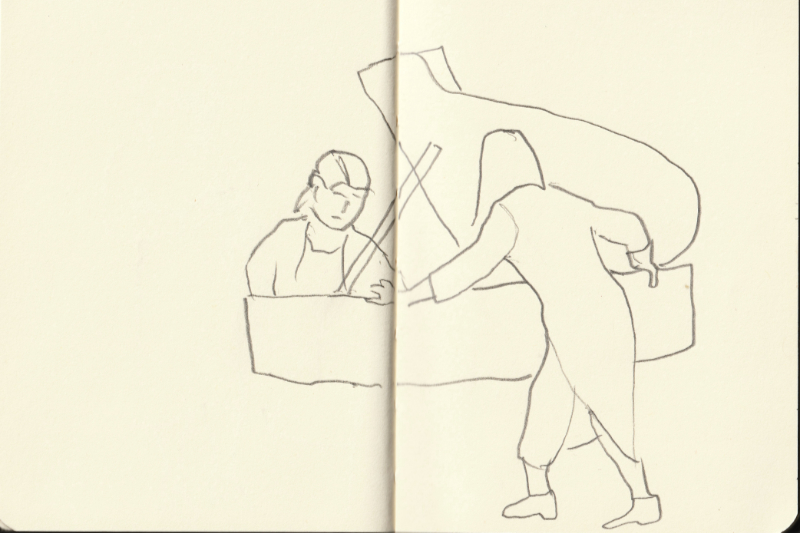
Erika Tazawa and Amy Petrongelli performing “Blue” by Andrew Staniland. (sketch by Jon Ciliberto)
Emily Koh’s hyd(e)r0sion (2022), composed for Bent Frequency, was tightly structured but with room for loose and free playing. To my ears included some of the “burst and ponder” compositional structures heard in Singleton’s piece — rapid flurries of coordinated saxophone and percussion followed by more spacious, diffuse sections.
Unexpectedly, the composer described the genesis of the composition from a literally mundane (but philosophically observed) experience: her neighbor’s yard work over a year and the Georgia red clay that eroded onto the sidewalk as a result.
I admit that my sense of composer George Lewis is forever referenced to his 1988 recording with John Zorn and Bill Frisell, News for Lulu, a recording of seminal works of hard bop by Kenny Dorham, Hank Mobley, Freddie Redd, and Sonny Clark, with Lewis’ trombone taking the role of double bass. It is a virtuoso performance.
Thus, perhaps, the sense of embedded or inherent swing I heard in his 2022 composition Tuning In, commissioned by and written for Bent Frequency and performed by Baker and Gerber, was perhaps entirely in my own mind. Baker noted the technical challenges of the work, including her occasional notes to the composer that what was on the page wasn’t actually possible. A captivating work, it read like an edge-of-the-seat story, the duo ably working through complex rhythmic architecture while maintaining a suppleness of feel.
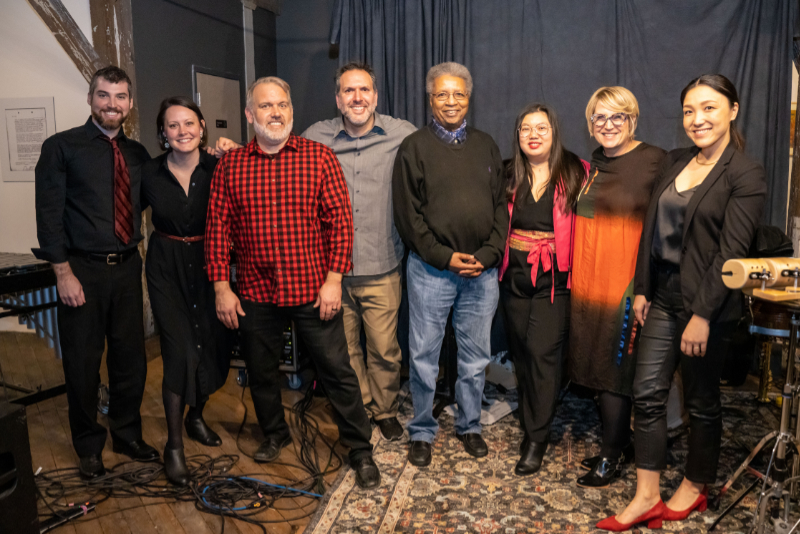
l-r: Daniel Tosky, Amy Petrongelli, Stuart Gerber, Adam Mirza, Alvin Singleton, Emily Koh, Jan Berry Baker, Erika Tazawa. (credit: Steve Eberhardt)
Eyedrum being Eyedrum, sounds of a party getting underway next door began to infiltrate toward the latter stages of “Tuning In,” a thumping bass drum that nearly matched the rhythm of Lewis’ composition. I thought, “this piece is difficult enough for the musicians,” who soldiered on despite the unexpected addition.
A word with the neighbors bought silence enough to allow the final work to proceed, Madrigals, Book I (1965), by George Crumb. Crumb passed away in early 2022, and Bent Frequency programmed it in his honor. The silence was needed, as this was the evening’s most “delicate” music.
Crumb constructed the work from fragments of poetry by Federico García Lorca, a writer with whom he had a long creative association. It was performed by Petrongelli, Daniel Tosky (double bass), and Gerber like gossamer in moonlight fragmented by determined sleepwalking. The trio brought an entirely different sonic landscape to the evening — diaphanous vibraphone, whispering and haunted voice, high harmonics and rumbling mallet bridgework on the bass — a palette cleanser as it were, light on the ears but ambiguous and engaging. ■
EXTERNAL LINKS:
- Bent Frequency: bentfrequency.com
- Alvin Singleton: alvinsingleton.com
- Adam Mirza: adammirza.com
- Andrew Staniland: andrewstaniland.com
- Emily Koh: emilykoh.net
- George E. Lewis: music.columbia.edu/bios/george-e-lewis
- George Crumb: georgecrumb.net

Read more by Jon Ciliberto.
RECENT POSTS
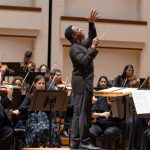 Kwamé Ryan and the Charlotte Symphony, with violinist Gil Shaham, deliver a rapturous all-Tchaikovsky evening • 11 Oct 2025
Kwamé Ryan and the Charlotte Symphony, with violinist Gil Shaham, deliver a rapturous all-Tchaikovsky evening • 11 Oct 2025 Equilibrium and elegance: Dover Quartet and de Guise-Langlois find balance in Haydn, Jalbert, and Mozart • 10 Oct 2025
Equilibrium and elegance: Dover Quartet and de Guise-Langlois find balance in Haydn, Jalbert, and Mozart • 10 Oct 2025



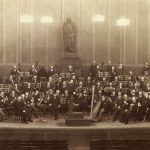
.png)